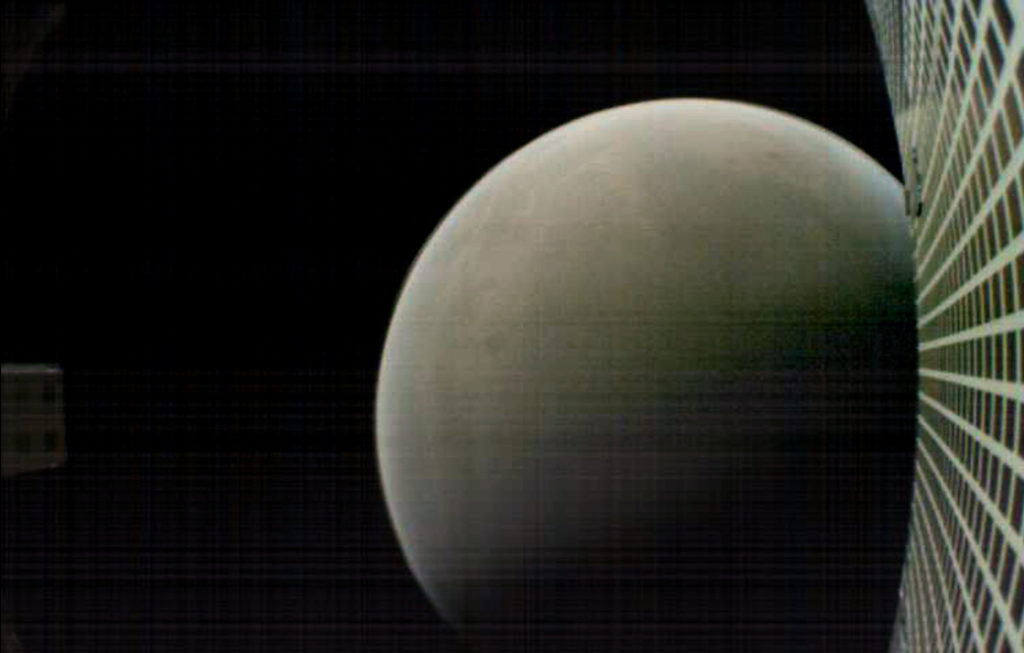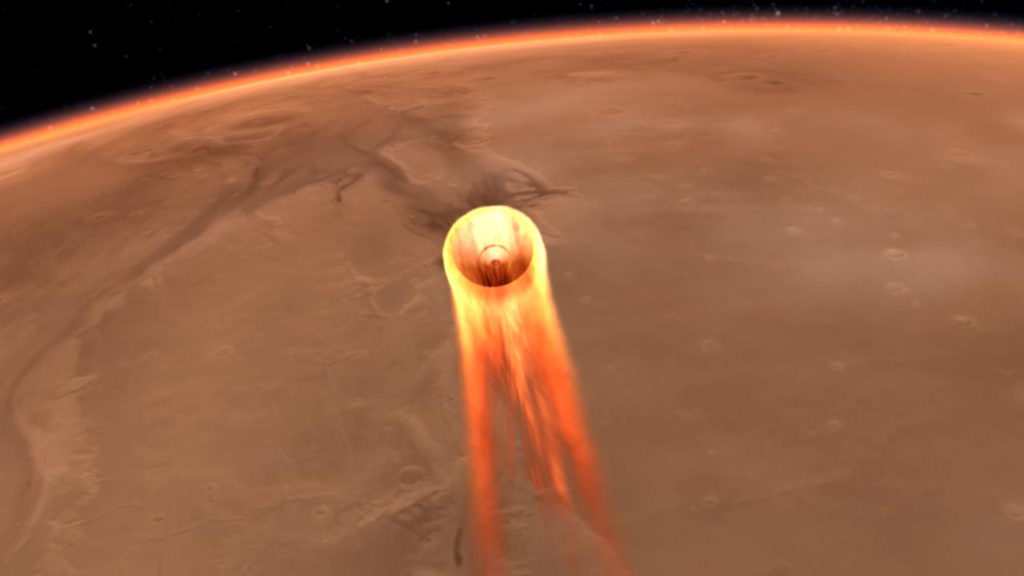 MarCO-B, one of the experimental Mars Cube One (MarCO) CubeSats, took this image of Mars from about 4,700 miles (6,000 kilometers) away during its flyby of the Red Planet on Nov. 26, 2018. MarCO-B was flying by Mars with its twin, MarCO-A, to attempt to serve as communications relays for NASA’s InSight spacecraft as it landed on Mars. This image was taken at about 12:10 p.m. PST (3:10 p.m. EST) while MarCO-B was flying away from the planet after InSight landed.
MarCO-B, one of the experimental Mars Cube One (MarCO) CubeSats, took this image of Mars from about 4,700 miles (6,000 kilometers) away during its flyby of the Red Planet on Nov. 26, 2018. MarCO-B was flying by Mars with its twin, MarCO-A, to attempt to serve as communications relays for NASA’s InSight spacecraft as it landed on Mars. This image was taken at about 12:10 p.m. PST (3:10 p.m. EST) while MarCO-B was flying away from the planet after InSight landed.
Month: November 2018
NASA’s InSight Sends First Pictures
 NASA’s InSight Lander has returned its first picture from Mars. A post-landing news is briefing expected at 2 p.m. PST (5 p.m. EST).
NASA’s InSight Lander has returned its first picture from Mars. A post-landing news is briefing expected at 2 p.m. PST (5 p.m. EST).
NASA’s InSight Spacecraft Has Touched Down on Mars
 Mission controllers at NASA-JPL have received a signal from NASA’s InSight lander on the Mars surface via MarCO OR a beep from InSight’s X-band radio. In the coming hours, engineers will be checking on the spacecraft’s health. A post-landing news briefing expected at 2 p.m. PST (5 p.m. EST).
Mission controllers at NASA-JPL have received a signal from NASA’s InSight lander on the Mars surface via MarCO OR a beep from InSight’s X-band radio. In the coming hours, engineers will be checking on the spacecraft’s health. A post-landing news briefing expected at 2 p.m. PST (5 p.m. EST).
InSight Blazes Through Top of Martian Atmosphere
 NASA’s InSight has begun its entry, descent and landing phase at Mars. Within seven minutes of entering the atmosphere, the spacecraft is expected to deploy its parachute, separate from its heat shield, pop out its landing legs, turn on its landing radar and start firing its retrorockets as it separates from its back shell. Touchdown is expected around 11:54 a.m. PST (2:54 p.m. EST).
NASA’s InSight has begun its entry, descent and landing phase at Mars. Within seven minutes of entering the atmosphere, the spacecraft is expected to deploy its parachute, separate from its heat shield, pop out its landing legs, turn on its landing radar and start firing its retrorockets as it separates from its back shell. Touchdown is expected around 11:54 a.m. PST (2:54 p.m. EST).
MarCO CubeSats Relaying InSight Data
 The first CubeSats to deep space — Mars Cube One A and B — have begun to relay communications from the InSight spacecraft as it lands on Mars. MarCOs’ transmissions may be interrupted during the landing process, but their signals do not affect whether InSight completes its activities.
The first CubeSats to deep space — Mars Cube One A and B — have begun to relay communications from the InSight spacecraft as it lands on Mars. MarCOs’ transmissions may be interrupted during the landing process, but their signals do not affect whether InSight completes its activities.
InSight Prepares to Enter Martian Atmosphere
 NASA’s InSight lander has separated from the cruise stage. It is turning to orient its heat shield in preparation for the entry, descent and landing process at Mars.
NASA’s InSight lander has separated from the cruise stage. It is turning to orient its heat shield in preparation for the entry, descent and landing process at Mars.
InSight in Position for Mars Landing
 Mission controllers at NASA’s Jet Propulsion Laboratory in Pasadena, California, have completed the final adjustments for landing NASA’s InSight spacecraft on Mars. Atmospheric entry is expected around 11:47 p.m. PST (2:47 p.m. EST) and touchdown, about seven minutes later. Watch live commentary at https://www.nasa.gov/live
Mission controllers at NASA’s Jet Propulsion Laboratory in Pasadena, California, have completed the final adjustments for landing NASA’s InSight spacecraft on Mars. Atmospheric entry is expected around 11:47 p.m. PST (2:47 p.m. EST) and touchdown, about seven minutes later. Watch live commentary at https://www.nasa.gov/live
Landing Day for InSight

NASA’s InSight spacecraft is on target for Mars landing at around noon PST today. Regular updates about the entry, descent and landing will be posted here.
In mere hours, NASA’s InSight spacecraft will complete its seven-month journey to Mars. It will have cruised 301,223,981 miles (484,773,006 km) at a top speed of 6,200 mph (10,000 kph).
Engineers at NASA’s Jet Propulsion Laboratory in Pasadena, California, which leads the mission, are preparing for the spacecraft to enter the Martian atmosphere, descend with a parachute and retrorockets, and touch down tomorrow at around noon PST (3 p.m. EST). InSight — which stands for Interior Exploration using Seismic Investigations, Geodesy and Heat Transport — will be the first mission to study the deep interior of Mars.
“We’ve studied Mars from orbit and from the surface since 1965, learning about its weather, atmosphere, geology and surface chemistry,” said Lori Glaze, acting director of the Planetary Science Division in NASA’s Science Mission Directorate. “Now we finally will explore inside Mars and deepen our understanding of our terrestrial neighbor as NASA prepares to send human explorers deeper into the solar system.”
Before InSight enters the Martian atmosphere, there are a few final preparations to make. At 1:47 p.m. PST (4:47 p.m. EST) engineers successfully conducted a last trajectory correction maneuver to steer the spacecraft within a few kilometers of its targeted entry point over Mars. About two hours before hitting the atmosphere, the entry, descent and landing (EDL) team might also upload some final tweaks to the algorithm that guides the spacecraft safely to the surface.
NASA InSight Landing on Mars: Milestones

On Nov. 26, NASA’s InSight spacecraft will blaze through the Martian atmosphere and attempt to set a lander gently on the surface of the Red Planet in less time than it takes to hard-boil an egg. InSight’s entry, descent and landing (EDL) team, based at NASA’s Jet Propulsion Laboratory in Pasadena, California, along with another part of the team at Lockheed Martin Space in Denver, have pre-programmed the spacecraft to perform a specific sequence of activities to make this possible.
NASA InSight Team on Course for Mars Touchdown

NASA’s Mars Interior Exploration using Seismic Investigations, Geodesy and Heat Transport (InSight) spacecraft is on track for a soft touchdown on the surface of the Red Planet on Nov. 26, the Monday after Thanksgiving. But it’s not going to be a relaxing weekend of turkey leftovers, football and shopping for the InSight mission team. Engineers will be keeping a close eye on the stream of data indicating InSight’s health and trajectory, and monitoring Martian weather reports to figure out if the team needs to make any final adjustments in preparation for landing, only five days away.
“Landing on Mars is hard. It takes skill, focus and years of preparation,” said Thomas Zurbuchen, associate administrator for the Science Mission Directorate at NASA Headquarters in Washington. “Keeping in mind our ambitious goal to eventually send humans to the surface of the Moon and then Mars, I know that our incredible science and engineering team — the only in the world to have successfully landed spacecraft on the Martian surface — will do everything they can to successfully land InSight on the Red Planet.”
InSight, the first mission to study the deep interior of Mars, blasted off from Vandenberg Air Force Base in Central California on May 5, 2018. It has been an uneventful flight to Mars, and engineers like it that way. They will get plenty of excitement when InSight hits the top of the Martian atmosphere at 12,300 mph (19,800 kph) and slows down to 5 mph (8 kph) — about human jogging speed — before its three legs touch down on Martian soil. That extreme deceleration has to happen in just under seven minutes.
“There’s a reason engineers call landing on Mars ‘seven minutes of terror,'” said Rob Grover, InSight’s entry, descent and landing (EDL) lead, based at NASA’s Jet Propulsion Laboratory in Pasadena, California. “We can’t joystick the landing, so we have to rely on the commands we pre-program into the spacecraft. We’ve spent years testing our plans, learning from other Mars landings and studying all the conditions Mars can throw at us. And we’re going to stay vigilant till InSight settles into its home in the Elysium Planitia region.”
One way engineers may be able to confirm quickly what activities InSight has completed during those seven minutes of terror is if the experimental CubeSat mission known as Mars Cube One (MarCO) relays InSight data back to Earth in near-real time during their flyby on Nov. 26. The two MarCO spacecraft (A and B) are making good progress toward their rendezvous point, and their radios have already passed their first deep-space tests.
